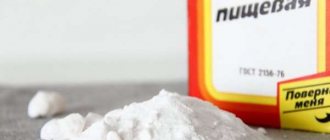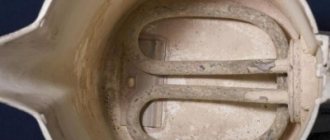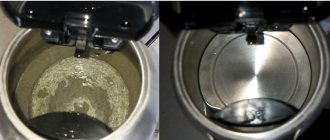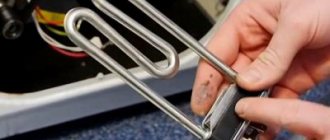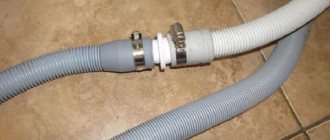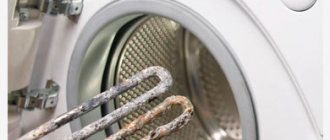- Cleaning with citric acid
Tap water often has increased hardness and various chemical impurities, which negatively affects the operation of the washing machine. The heating element, the heating element, is especially susceptible to scale formation. To understand the causes of scale, ways to combat it and preventive measures, we recommend that you read our article.
How to clean the heating element in a washing machine
The heating element in the washing machine is responsible for heating the water for high-quality and efficient washing. Unfortunately, it most often fails. There are two main causes of failure: short circuit and scale. As a result of a short circuit, the heaters or their contacts burn out; when scale occurs, the element overheats and fails.
After reading the article, you will learn how to clean the heating element of a washing machine from scale.
Odor removal
You can remove the musty smell from your washing machine with vinegar while descaling it using this product. An acidic environment copes well with mold and creates negative conditions for the proliferation of fungi. It turns out that in order to remove the smell, you need to act in the same way as when removing limescale. Most likely, one time will not be enough to remove the smell from the machine. In this case, repeat the cleaning procedure using vinegar, adding baking soda.
Soda, like vinegar, needs to be added to the cuvette in an amount of 50-100 grams and run the washing program. You can enhance the effect of removing unpleasant odors by adding aromatic additives based on essential oils. In any case, once cleaning is complete, run a short wash or rinse program to remove any remaining vinegar, baking soda, and dirt.
How to descale a washing machine: effective means and methods
The trays are left in this solution for 2 hours. Then rinse under running water, wipe dry and put in place.
Expert opinion
Ekaterina Korneva, expert in the field of care, cleanliness and beauty
I will help you understand all the intricacies.
Cleaning the washing machine with vinegar allows you to avoid disassembling the equipment to remove plaque manually using abrasives. To do this, you need to try to consider the state of the heating element through the holes of the drum. How to clean a washing machine from scale If you have any questions, please contact me, I will be happy to answer!
Why does plaque appear?
Scale on heating parts occurs due to hard water. When water exceeds the content of insoluble calcium and magnesium biocarbonate, it leaves a sediment. It sticks to the heating element and other parts of the washing machine.
Should you be afraid of scale?
If scale is not removed in time, then over time the heating element becomes so overgrown with it that it ceases to function normally. Besides:
- To effectively wash in hard water, you need to use more detergent. It is known that clothes are washed better in soft water.
- When plaque forms on the heater, it prevents it from delivering the proper amount of heat. Therefore, much more electricity is consumed to heat the water.
- A burnt heating element can cause a malfunction of the electronics, control board elements, and wiring. Such repairs will cost much more than timely cleaning of the element.
Moreover, flying pieces of scale during washing end up in the drum and drain pipe, which can lead to serious damage. Therefore, it is important to know how and how to clean the heating element in a washing machine from scale.
Famous cleaning products
In stores and markets you can find a large number of cleaning products from various manufacturers. The most popular and advertised is Calgon, which supposedly prevents the appearance of scale in the SMA.
Studies have proven that Calgon has minimal impact on water quality. Therefore, the plaque will still settle on the parts, just a little slower.
Every manufacturer who advertises their product and knows how to remove scale from heating elements uses marketing techniques. Simply put: every expensive product contains regular citric acid. So what's stopping us from using it at home?
Aids
Removing a copper heat exchanger from an indirect heating device is not so easy, but conventional large-capacity models can take all day to disassemble and reassemble. In this case, cleaning the boiler with chemicals will help, without disassembling or removing the device.
Visit the store and buy a product created specifically for such purposes. As an alternative, you can prepare a concentrated solution of citric acid (half a kilogram of acid per 2 liters of water)
It doesn’t matter what exactly you choose
To pour the product inside, empty the container by a third through a hot water tap. Connect the hose to the drain fitting and pour the solution through it, while lifting the end of the pipe above the boiler. Leave for several hours. Then drain the solution and rinse the tank, draining the water several times and refilling it again. Connect the device, heat the water and drain it again. The water heater is ready for use.
Cleaning a boiler is a simple process, but it is better not to carry out the procedure alone - water heaters can be very heavy.
- If you use chemicals, make sure that they do not come into contact with rubber seals - they may lose elasticity, causing the boiler to leak.
- Double check every operation you perform. The water heater will not work after assembly if done incorrectly.
- Connect and disconnect power only when the tank is full of water.
- When you have finished flushing, fill the boiler with water and wait a while. If the flange does not leak, great, you can use the device.
- If you use chemicals, be sure to wear gloves and a protective mask.
Now you know how to clean a boiler without calling a technician. This is a fairly simple and relatively quick process that any owner can handle. The main thing is to carry out this operation in a timely manner so that the device serves you for a long time. Remember: professional boiler repair is a costly process.
How to clean a boiler in 3 ways
You can clean the boiler yourself if you approach this process competently. You can get true pleasure and a relaxed body from hot water, and besides, a hot bath will relieve your psyche. In order to fill a person's life with hot water, a boiler is needed. This human invention, if properly handled, will improve the process of obtaining hot water until it becomes automatic. The key to a long service life of this device is rational and proper care of the item. We must pay tribute to the boiler for the pleasure we experience from taking a bath, and the simplest gratitude would be the regular cleaning of this miracle of technology. The safest, but most expensive way would be to entrust this matter to professionals, but this is too easy. Cleaning this electrical device at home is quite simple. It is enough to be careful and patient, and also to learn about some of the nuances.
Removing scale at home
Take citric acid to clean the heating element in the initial stages of contamination or for prevention in new washing machines.
- Add 150-200 g of citric acid to the dispenser in the powder compartment.
- Now select the longest wash cycle without spinning, with a water temperature of 60 degrees.
Note! Cleaning with citric acid is carried out in an empty washing machine. Therefore, empty the tank of laundry in advance.
- Wait until the cycle finishes before descaling. Now open the loading hatch.
- By bending the rubber cuff, remove pieces of scale and debris from the cracks.
- Wipe the inside of the drum thoroughly with a microfiber cloth that absorbs water well.
It is important to perform this cleaning regularly, since a single application will not protect the elements from further damage by plaque. It is recommended to use citric acid once every three to four months.
We use chemistry
Chemicals for descaling heating elements are as effective as they are dangerous if used incorrectly.
How to do it right:
- Add the product according to the instructions to the CM drum.
- Set the temperature to 60-90 degrees, start washing without laundry.
- Clean no more than once a month.
The danger of chemicals is that exceeding the dose can damage the rubber elements of the washing machine. For example, cuffs, hoses. The chemical will corrode the rubber, leading to loss of seal and leakage.
Another danger of chemicals: if the heater is heavily damaged by plaque, pieces of it during such cleaning can stop the operation of the MAS or clog the drain tract.
In this case, it is better to remove the heating element from the car and then start cleaning it.
Folk remedies
You can remove salt deposits from the heating element of a washing machine not only using chemicals, but also using folk remedies and substances that are found in every home. Mainly used are citric acid, vinegar and tribasic carboxylic acid.
Cleaning with citric acid
You can choose household acid, which can be purchased in stores, or specialized acid, which is used for cleaning equipment in industry and has a higher concentration.
The concentration must be clearly calculated based on the millimeters of area covered by scale. Liquid with a concentration of more than 10% corrodes the parts of the washing machine, and if the percentage is below 4%, the use of liquid will be ineffective.
To remove scale using this product, you must follow these steps:
- remove things from the drum, the tank should be empty;
- close the door tightly, and pour 3 tbsp into the powder compartment. household citric or carboxylic acid;
- select the boiling mode, that is, the maximum temperature of 90-95 degrees;
- for maximum efficiency, set an additional rinse to completely remove scale from the unit;
- expect 2-3 hours of washing in this mode, after which all internal parts will be clean from scale;
- after the end of the program, check the drain hose and rubber elements for the presence of large scale particles;
- Wipe dry all visible interior surfaces of the washing tub with a sponge.
It is recommended to carry out the procedure no more than twice a year, this way you can return the unit to cleanliness and save electricity.
Alternatively, you can use a mixture of citric acid and bleach in equal quantities. The same cleaning procedure is applied in the selected mode. After this, not only will the scale be removed, but pathogenic microorganisms will also be destroyed. You should not use this procedure often, because chlorine can corrode the rubber elements of the washing machine.
Vinegar as an effective descaling agent
Cleaning procedure using vinegar:
- remove all items from the drum;
- pour 2 cups of 9% vinegar into the liquid compartment and select the longest wash cycle with the boil mode;
- after the water has filled, pause the washing machine for 1 hour so that the solution dissolves the scale;
- then turn on the wash cycle, and after it finishes, turn on the shortest wash cycle to effectively wash all internal parts of scale and vinegar residues.
Thanks to this method, not only deposits are washed off from the heating element, but also soap deposits from other internal parts. Bacteria and musty odors will also be removed. After this, wipe all visible parts of the drum and rubber inserts dry.
How to get the heater
For front-loading washing machines, the element can be located in both the front and back.
Try to visually determine where the heating element is by inspecting the front and back panels. Usually it is hidden behind a wider lid.
To remove the element, remove the CMA panel.
- Remove the top cover by unscrewing the two bolts at the back.
- Pull out the dispenser tray by pressing the latch.
- Unscrew the control panel screws and lift it up.
- Remove the bottom cover, unscrew the screws there.
- Open the hatch door, bend the cuff, remove the metal clamp.
- Disconnect the wires of the electronic lock (UBL).
- Remove the front panel.
The heater in this case is located under the tank. You need to press out all the connectors leading to it, loosen the central nut and push it inward.
To remove the back cover, you only need to unscrew the mounting screws to get to the element.
How to remove scale? To do this, remove the temperature sensor from the heating element and rinse it under running hot water. Remove the pieces of stone that are removed by hand. Do not forcefully scrape off the scale, otherwise you may damage the body.
- Take a two-liter plastic bottle.
- Cut off the neck and fill the container with hot water.
- Dissolve three to four tablespoons of citric acid in water.
- Place a heater there.
- Leave it for a day.
The acid breaks down the components of the water stone. After that, all you have to do is remove the coating - and you will get a clean part.
Then install it in place and do not forget about prevention.
Traditional methods of cleaning a car
- Fungus and mold in the sealing gum and, accordingly, the appearance of unpleasant odors;
- Scale on the heating element;
- Residues of powder, rinse aid and other additives inside the machine;
- Dirt and small things in the drain pump filter;
- Rust and sand in the inlet hose filter.
If you do not get rid of it in time, then not only the machine, but also the person living in the apartment may suffer. The fungus produces a huge number of bacteria that cause allergies and pulmonary diseases.
How to avoid scale formation
As you understand, water softeners are not always effective. It is much more profitable to install a magnetic softener. This device allows you to efficiently break down salts that form sediment in water. Consequently, plaque will not settle on the parts of the washing machine.
It is located on the inlet hose or water pipe.
Don't forget that softened water requires less detergent than hard water. Therefore, be careful not to cause increased foaming in the SM.
It is recommended to wipe the inside of the washer and the cuff after each washing cycle. Leave the door open to allow the machine to dry.
Now you know how to clean the heating element in a washing machine. The main thing is not to delay, and to carry out timely scale prevention. You may not be able to use other water, but you can certainly use our tips to improve its quality.
A video on the topic will help you:
Benefits of Cleaning with Vinegar
- the machine may refuse to draw water because the standard device is clogged;
- the water coming from the pipe has many different impurities that settle on the elements of the unit, which leads to the formation of scale in the washing machine;
- the drain pump may break down before the time allotted for its operation.
Soda, like vinegar, needs to be added to the cuvette in an amount of 50-100 grams and run the washing program. You can enhance the effect of removing unpleasant odors by adding aromatic additives based on essential oils. In any case, once cleaning is complete, run a short wash or rinse program to remove any remaining vinegar, baking soda, and dirt.
Folk remedies Recipes for masks At home Hair loss in women How to stimulate growth Causes of hair loss Hair loss in men Review of vitamins Helpful tips
How to clean the heating element of a washing machine from scale and why it appears
When the washing machine becomes dirty, namely when scale appears on the heating element, the question arises of how to clean the heating element of the washing machine from scale.
For different SMs, the heating element can be located both in the front and in the back. If you need to clean the heating element, you first need to understand where it is located in this particular machine model. If there are no instructions where this is shown schematically, then its location should be visually determined.
Most often, heating elements are located behind a wide cover. In order to remove the heating element from the washing machine, you need to remove the CMA panel.
If the heating element is located in front, then it is necessary:
- Unscrew the two screws at the back and remove the decorative cover located on top;
- By pressing the latch (sometimes you need to turn the lever), remove the detergent dispenser container;
- Lift up the control panel by unscrewing the screws;
- Remove the bottom cover in the same way by unscrewing the bottom bolts;
- Having opened the hatch, bend the cuff and remove the metal clamp;
- Release the terminals of the UBL (hatch blocking device) from the wires;
- Finally, remove the panel covering the front of the heating element.
In this case, the heating element is located at the bottom of the tank. Therefore, to get it, you need to loosen the nut located in the center, move the connectors leading to the heating element and push the nut inward. After this, you can remove the heating element from the machine.
If the heating element is located behind the back wall of the machine, as in many Samsung models, then you only need to unscrew the mounting screws to remove the heating element.
Before cleaning the heating element from scale, it is necessary to remove the temperature sensor from it and wash it in hot water. You should remove all easily breakable stones by hand, never using hard objects to avoid damaging the body.
Lemon acid
Pour hot water into a plastic bottle or other container with a volume of about two liters, after cutting off the neck. Citric acid, in the amount of 3-4 tablespoons, must be dissolved in water. Place the heating element inside the bottle and leave for a day.
The water stone formed on the heating element must be dissolved by the acid. After the heating element is removed from the container a day later, all that remains is to remove the deposits from it and wipe the clean part. The heating element is installed in its original place.
Vinegar
To destroy scale in SM, you can use vinegar. This is also a fairly economical option.
Pour 2 cups of 9% vinegar into the washing powder container and wash in an empty machine at high temperature on the longest cycle. After the machine has filled with water, it must be stopped and allowed to stand for about 1 hour. During this time, the process of destruction of scale on the internal parts of the machine should begin.
After an hour, you need to start the machine and continue washing on the shortest cycle. This is necessary so that the internal parts of the machine are rinsed from residual vinegar and scale.
You shouldn't clean your car with vinegar often. Once every six months is enough. And to eliminate unpleasant odors, you can add a little vinegar to the detergent tray when washing rough items.
Instructions for use
Citric acid is sold in stores in the baking department. Citric acid can be used to clean the washing machine both inside and outside. Let's consider each method of application in more detail.
Cleaning inside
Scale accumulates in places hidden from view. To clean the inside of the washing machine from mucus, plaque, lime deposits and other contaminants, you need to use citric acid once every two months. The same remedy is also relevant if an unpleasant odor appears inside the device. During the cleaning process, the washing machine drum should be empty, without laundry. If you have never cleaned the device before, or more than 6 months have passed since the last procedure, take the maximum amount of powder (150–200 g for machines with a load of 5 kg or more, 100 g for machines with a load of 3–4 kg).
So, to carry out routine internal cleaning of your washing machine, proceed as follows:
- Make sure there is no clothing in the drum.
- Place citric acid in the detergent compartment (70 g for machines with a load of 3-4 kg, 100 g for machines with a load of 5 kg).
- Set the cotton washing mode to 60 degrees (if heavily soiled - 90 degrees), including rinsing.
- At the end of the wash, open the door and inspect the rubber seals for deposits of scale and undissolved citric acid. If found, remove them and wipe the surface with a cloth.
Citric acid can also be poured directly into the drum, but then the detergent compartment will not be cleanable.
Cleaning outside
A solution of citric acid is suitable for mechanical cleaning of external parts of the device. Citric acid can also be used to clean external parts of the structure from dirt and dust. A weakly concentrated solution is suitable for this. Proceed as follows:
- Pour 3–4 liters of warm water into a basin.
- Add 20 g of citric acid.
- Stir until the crystals are completely dissolved.
- Take a cotton cloth or microfiber cloth and soak it in the solution.
- Wipe the outside of the washing machine, as well as the rubber seals on the drum and the detergent compartment.
- Wipe the surface dry with a cloth (no rinsing required).
Useful tips
To prevent scale formation, washing at 60 degrees is sufficient. To achieve optimal results and take care of your assistant without harming her, it is important to consider the following nuances:
- The water temperature should not exceed 90 degrees. Otherwise, the chemical effect on the rubber and metal parts of the device may be too intense and lead to their damage. To prevent scale, a sufficient temperature is considered to be 60 degrees. For severe contamination, a single “run” with citric acid at a temperature of 90 degrees is permissible.
- Use no more than 200 g of crystals. 100 g is enough to dissolve up to 80 g of limescale during routine cleaning. In case of heavy contamination, the quantity can be increased, but not more than 200 g. Otherwise, there is a risk of harming the internal parts of the device.
- Only powdered citric acid is suitable for cleaning; it cannot be replaced with lemon juice or other similar products, since the concentration of the active substance is insufficient.
Do not leave the house during a wash cycle with citric acid; the drain hole may become clogged with large scale fragments. If you do not remove them in a timely manner, the device may leak or malfunction. If you hear an unusual noise, whistling or grinding noise while draining water, press the pause button to pause the device. Check the drain hole for blockages. You may need to wait until the door is unlocked and check for foreign pieces in the laundry compartment. After cleaning the machine with citric acid, inspect the special compartment for small parts (usually at the bottom on the facade of the device), clean it with a sponge, brush or brush.
Other reagents
In order to clean the heating element, you can also use chemicals. However, it should be remembered that they are equally dangerous if safety rules are neglected, as they are effective.
To properly clean the heating element using chemical reagents you need:
- Pour or pour the product into the drum of the machine;
- Set the washing mode at 60-90 degrees and start it without putting laundry in the drum;
- For preventive purposes, repeat this procedure monthly.
Chemical reagents are also dangerous because an overdose leads to the destruction of machine parts made of rubber or delicate plastics. Such as hoses and cuffs. If the rubber is corroded, the parts lose their tightness and elasticity, resulting in a leak in the washing machine.
Chemicals should be used with extreme caution, because if large pieces of plaque clog the drain system or stop the machine from operating, this can lead to electronic failure or leakage. If this does happen, then you need to immediately remove the heating element from the machine and clean it.
Cleaning the heating tank
Flushing the inside of boilers is as important as cleaning the heating element. Place a bucket, open the cold water tap and wait until it washes away the remaining scale from the water heater. For convenience, you can remove the device from the wall.
In case of particularly heavy soiling, remove the scale manually. Do not use abrasives or hard objects - this is unacceptable on an enamel surface. Do not touch the magnesium rod; if anything happens to it, you will have to buy a new part. If you cannot remove scale, you must dismantle the device and clean it with chemicals.
After cleaning, assemble and connect the water heater. Remember: all parts must be dry.
Causes of scale
The cause of scale on the heating element is hard water and mineral salts dissolved in it. When the content of magnesium and calcium biocarbonate in the water exceeds, sediment remains. It is this that settles on the heating element and other parts of the SM, leading to breakdowns and leaks.
When washing in hard water, more washing powder is required. And in soft water, clothes are washed much more efficiently.
If plaque appears on the heating element, it does not allow the element to transfer the heat necessary for washing to the water. As a result, more electrical energy is required to heat the water.
If the heating element burns out, the electronic board or its elements may fail and this will result in costly repairs.
What causes scale accumulation on heating elements?
Salts have low thermal conductivity. Accordingly, when scale forms on the surface of the heating elements, the heat exchange between water and the heater deteriorates.
- the time required to heat water to a given temperature;
- electricity consumption.
The efficiency of a heater covered with scale is reduced and it may overheat or burn out. A short circuit is also possible, and if the electrical wiring is carried out in violation of safety rules, then a fire. Therefore, it is very important to monitor the condition of heating elements in boilers, washing machines and dishwashers.
Pollution prevention
As a preventive measure, it is easier to use citric acid to clean the heating element.
Prevention is performed as follows:
- A glass of citric acid is poured into the washing powder tray;
- The longest wash cycle is selected, without using a spin cycle, at a water temperature above 60 degrees. Important: cleaning with citric acid is carried out without putting laundry in the drum.
- Before descaling, you must allow the machine to finish the selected wash cycle;
- The loading lid is opened and, by bending the cuff, pieces of water stone, dirt and debris that have fallen there are removed;
- The drum is wiped with a soft cloth that absorbs water well.
It is important to carry out such preventive actions regularly, without leading to the appearance of a thick layer of deposits on the heating element. At least four times a year.
To prevent scale formation, you can use a magnetic softener. It is more effective than commercial water softeners.
This device quickly breaks down salts that form sediment in water. Thus, plaque will not remain on the components of the washing machine.
A magnetic softener is installed at the cold water inlet of the washing machine on the hose itself or on the water supply.
When using a water softener, it is necessary to take into account that when washing clothes in soft water, less washing powder is required than in hard water. Otherwise, increased foaming will occur and you will have to stop the wash cycle and remove the foam.
After each wash, you need to wipe the machine, its inside, especially the cuff dry. The door should be left open until the machine is dry.
In what cases is cleaning with citric acid required?
It is recommended to clean the internal parts of the washing machine from limescale every 3 months. In those places of residence where hard water flows from the tap, such preventive measures should be carried out after 30 washes. You can focus on lime deposits. They can boil on the heating element located under the drum. If you shine a light on the heating element, a layer of plaque will be visible. Limescale makes itself felt by the musty smell of things after washing. Also, the device starts to work very noisily, yellow and gray spots will appear on light-colored clothes, even if you use a good powder, the washing quality will be poor.
Some try to remove it with a 9% vinegar solution. But it has a significant drawback - a pungent odor. For a long time, washed items will smell like this. Lemon has no such drawback.
How and with what to clean a washing machine: the best methods + review of special products
Do you want to extend the trouble-free operation of your washing machine by cleaning its main elements? Agree, it’s great when the washing machine works like a clock: load the laundry, pour in the powder, press start. To do this, it is worth remembering the most important thing: any equipment needs care.
But the range of detergents is very rich and you don’t know which of them can cope with the task? We will help you figure out how and how to clean your washing machine from a variety of contaminants - from scale to banal dirt and the ubiquitous fungus.
The article discusses effective methods of cleaning the heating element with an overview of the most effective means. To avoid breakdowns of expensive appliances, floods and other consequences of oversight, we offer step-by-step instructions on how to perform comprehensive cleaning of all important components and elements of the washing machine.
We have selected photos depicting important stages of the process, as well as useful videos demonstrating the prevention and maintenance of the unit on our own.
Cleaning boilers of various brands
In general, the procedure for descaling water heaters is always the same. But when dismantling and cleaning, models from different manufacturers have their own characteristics.
For example, products have their own characteristics and they lie in the method of fastening and the shape of the flange. You need to remove it like this: push the flange towards you, turn it over (while still in the device) and only then take it out. After cleaning the heating element and tank, insert the flange back, remembering to check the tightness of the connection. If necessary, change the gasket. The heating elements in Ariston boilers are located at the very bottom, so it is not at all necessary to remove the device from the wall.
Storage water heater ARISTON
Now about the features of cleaning water heaters from another well-known manufacturer - Gorenje. Their peculiarity is that the front panel is quite difficult to remove. At least at first glance. In reality, everything is simple: press the bottom edge of the panel and pull it towards you a little. After this, the panel will easily pop out, because it is held on only by a pair of plastic clips. The second feature of the products from this manufacturer is their impressive weight, so it is unlikely that you will be able to remove the device from the wall alone. In addition, there is a risk that you will flood the electrical installation elements with water.
Another very popular brand is Termex. The design of such products is almost the same as in previous versions, so cleaning is also easy. The only difference is the magnesium rods, which need to be replaced almost annually.
Storage water heater THERMEX
Why should you clean your washing machine?
Although the purpose of the machine is to “give” us clean things, the condition of the device itself may be far from sterile.
Dirt removed from clothing during washing accumulates on the internal elements. Black spots of mold can often be replaced on the sealing gum and the edges of the drum, because heat and moisture are ideal conditions for the development of fungal organisms.
And the heating element and other parts are gradually covered with a coating of salts that are in the water.
Main sources of pollution:
- high mineralization of water;
- use of aggressive chemicals and low-quality detergents;
- improper operation of the device;
- washing heavily soiled items - overalls with residues of mortar or machine oil, clothes after gardening work, etc.
So, in order to bring your assistant into a perfectly clean appearance, it’s time to do some general cleaning, starting from the body itself and ending with the internal parts.
To wash away obvious external contaminants (stains of gel, conditioner, traces of powder), warm water and a sponge are enough. But you will have to work hard with the parts hidden in the depths of the unit.
And a little about prevention
- Use only as much powder, bleach and conditioner as you actually need (see product manufacturer's instructions). After all, excess detergents do not enhance the result, but simply settle and accumulate inside the washing machine.
- Always remove small items from pockets to prevent them from clogging the drain filter.
- Try not to delay starting the machine if you have already thrown dirty things into the drum. Well, take out clean clothes immediately after washing and send them to dry.
- Try to always keep the car open to prevent mold from growing in it due to high humidity.
Did you like the article? Subscribe to the channel to stay up to date with the most interesting materials
We remove scale from the heating element and internal elements
One of the most serious accidents that can easily happen if you do not properly care for your washing machine is the failure of a tubular electric heater.
Since the heating element is in contact with running water, scale forms on it after each wash - deposits of calcium and magnesium salts.
Therefore, if a softening filter is not installed in the drain, it is recommended to add special agents to the powder (for example, Calgon) and carry out preventive maintenance at least once a month.
Method #1 - improvised materials from stocks
One of the simplest and most effective ways to combat lime deposits is to pour tribasic carboxylic or citric acid into the powder compartment and turn it on at any high temperature setting.
This recipe works simply: when heated, the acid actively corrodes not only light deposits, but also caked limestone, as a result of which it cleans both the heating element and the steel of the drum.
Calculation of the required amount of powder must be done based on the degree of contamination of the machine and its container. On average, for every kilogram of loading there is about 25-30 grams of acid.
If the unit has not been cleaned for a long time, you can take note of the following advice: pour acid into the powder container, run any long washing mode with a temperature of 90°C and above and turn off the power from the network halfway through the process. Leave it overnight and start the machine again in the morning.
It is recommended to use this procedure no more than 4 times a year, and after each time you must check the drain hose and drum cuff to remove large particles of loose limestone.
Other home remedies and their uses:
- Table vinegar - pour 1-2 cups of a 9 percent acetic acid solution into the detergent cuvette, select a high-temperature mode with long washing and pre-soaking. To get rid of the specific sour smell, you can then turn on an additional rinse.
- Baking soda and vinegar - to enhance the effect of acid on limescale, a special solution will be useful. It is prepared like this: half a glass of soda is mixed with the same amount of water and placed in a container for powder, and 1 glass of 9% vinegar is poured into the drum. Then the machine starts in any long-term mode at maximum temperature.
- Bleach and other chlorine-containing products are used in the old fashioned way by many housewives for comprehensive cleaning and disinfection of the washing machine.
But in fact, the effectiveness of caustic preparations is very doubtful: they will not save you from scale, but some elements (for example, the rubber drum seal and various sealing gaskets) can cause great damage. And chlorine vapors are harmful to health.
But we looked at the most reliable, cheap, safe and practice-tested methods for getting rid of scale using improvised means.
Method #2 - special chemicals
The cleaning agent for washing machine elements must be safe for humans, fabrics and all internal surfaces of the device, and also effectively remove lime deposits and other contaminants.
Specialized preparations have an important advantage over “folk” ones - their composition is developed taking into account the design features of the device and does not harm some elements while cleaning others.
- Topperr 3004 (Germany) – descaling cleaner, suitable for dishwashers and washing machines. It removes scale of varying degrees well, recommended by Bosh manufacturers.
- Schnell Entkalker is a powder for quickly cleaning internal elements from stubborn lime deposits. Produced in Germany, available in 200g packs.
- Antikalk for Washing Machines from Sano (Israel) is a universal gel for the prevention and elimination of small plaque with an antibacterial effect.
- Magic Power (Germany) is one of the best specialized products for washing machines. Available in the form of gel and powder, which effectively removes plaque from heating elements, tanks, and drums.
- Beckmann (Germany) is a universal product that will protect against scale and eliminate unpleasant odors caused by various contaminants. But, like any multi-purpose product, it is good for regular care, but will be ineffective against heavy dirt.
- Filtero 601 (Germany) – works well to remove old scale from the heater and other elements; it is recommended to use 3-4 times a year for intensive cleaning of the machine. Available in 200 g bags for one use.
- Doctor TEN (Russia) and Antinakipin (Belarus) are analogue powder preparations intended only for removing scale, but from any equipment. An inexpensive and convenient solution to the problem of lime deposits on the heating elements of both washing machines and dishwashers.
Please note that many products that, judging by the advertising, are guaranteed to protect our machine from problems with plaque, will not get rid of existing scale, but will simply reduce the concentration of salts in the water, for example, the same Calgon.
It is easy to distinguish between them - it is recommended to add such preparations before starting the machine along with the powder or directly into the drum, and they are used when washing things.
Method #3 - manual cleaning
If you have never thought about how to clean your washing machine and all its key elements before, and the assistant has served you for more than one year, it is recommended that you first carry out a visual inspection of the heating element.
Most likely, a multi-layered limestone has already formed on the heating element, which will be easier to remove manually - with standard cleaning methods, broken-off solid plaque particles may remain inside the unit.
To clean the heating element we proceed in stages:
- Disconnect the wires, sensor and remove the heating element. Scale and dirt can interfere with the process, so after loosening the fastening, carefully pry up the metal flange with a flat-head screwdriver. But be careful and proceed smoothly so as not to damage the tank itself and the wiring.
- We rinse the heating element under good pressure with warm water to remove loose deposits and dirt.
- We make a concentrated solution to remove stone residues: pour 3-4 tbsp into a plastic bottle with a cut off neck. citric acid powder, place the heating element inside and fill with hot water to the level of the bar.
- Shake the liquid to activate the cleaning process. Rising air bubbles will indicate that magnesium and calcium salts have begun to dissolve.
In this state, we leave the heating element to soak overnight. And in the morning, we rinse the metal under running water with a soft sponge, wipe it dry, admire the glare of light on the sparkling stainless steel and install the element back into the device.
By the way, if you take the machine apart, you can also inspect the condition of the drum. You may have to dismantle it too in order to thoroughly clean all the holes and remove scale and mold.
But you shouldn’t do this without extreme necessity and skills in working with equipment; you can get by with treatment with a good special tool.
Cleaning a tubular electric heater
The heating element is 10 times more susceptible to breakdowns, which often arise precisely because of scale. Moreover, this problem is getting closer with every wash. And then the moment comes when, due to a large accumulation of scale, the automatic program cannot even start the wash. It will become clear that the electric heater has failed when the machine suddenly turns off in the middle of operation. The problem is clear, so we need to start fixing it.
Cleaning with citric acid
“Limonka” is very often used for cleaning scale. The amount required for cleaning is determined by how heavily “overgrown” the tubular element is. A machine with a 5 kg load of laundry will require approximately 5 sachets of citric acid. One must be poured into the drum, and the rest into the powder compartment. Then select the washing mode at 95 degrees temperature.
This cleaning method can be used no more than once every 2 weeks.
Cleaning with acetic acid
Cleaning with vinegar is a less popular method, but still relevant. It is worth remembering that this acid is much more aggressive than the previous one, so you need to be extremely careful not to damage the rubber parts of the machine. But this option will cope with shadow deposits much faster.
Just 50 ml needs to be poured into the powder compartment to cope with the problem. But all this is done only at your own peril and risk, since you cannot predict what the results will be.
Procedure for comprehensive cleaning
In addition to scale, there are other problems that can be caused by improper operation of the machine: dirt, unpleasant odor, mold. Therefore, you should regularly maintain the cleanliness of the internal elements.
Step #1 - wash the drum
After each wash, residual water and dirt remain in the drum. And soon black spots appear in the folds of the sealing cuff, and a musty smell comes from the depths of the machine.
Starting at idle speed with the addition of disinfectants or regular citric acid will help solve the odor issue. But the gum needs to be thoroughly cleaned by hand.
The easiest option is to carefully push the folds apart, wash the cuff around the circumference with a sponge, soap and warm water, and then wipe dry.
If you notice mold stains, you can use a solution of copper sulfate or prepare a cleaning paste of water and baking soda in equal proportions.
Then thoroughly treat the elastic band and the entire drum with this mixture, leave for a couple of hours, and then wipe with a sponge and start the long-term wash cycle.
For more information on cleaning your washing machine drum, see this article.
Step #2 - clean the filter and drain hose
The cause of an unpleasant odor can also be debris invisible to the eye - hair, particles of soil or building materials, lint, feathers and various small objects that were not removed from clothing pockets in time.
All this accumulates in the filter and hose through which the machine releases waste water. It is recommended to clean the washing machine drain filter at least once every 3 months, and more often during active use.
To do this, you need to remove the protective panel, place a small container for draining water or place a rag on the floor. Then unscrew counterclockwise and remove the filter. Rinse it under high pressure water and remove accumulated debris from the hole.
To rinse the hose, you need to drain the remaining water in the machine through the drain filter and then disconnect it from the entrance to the sewer pipe or siphon. After this, you can remove the part, but exactly how to do this depends on the design of the device itself.
For example, in Ariston, Samsung, Indesit, LG, Whirpool, Ardo machines, you can only get to the hose connection through the bottom.
To do this, you need to lay the device on its side, remove the bottom panel and filter, and loosen the clamp with pliers. All that remains is to disconnect the pump and remove the hose itself.
In Electrolux and Zanussi machines, you need to look for the drain fastening behind the rear panel, and in Bosch and Siemens - behind the front, when it comes to front-loading machines.
But for vertical models, you can only get to the hose through the side cover. Therefore, it will not be superfluous to check the instructions, which describe the device diagram.
To clean the drainage hose from dirt and powder deposits, equip yourself with a thin non-metallic cable with a mini brush attached to one end.
We run this brush inside, scroll it and gradually move it to the end of the hose. Then rinse under pressure of warm water. For severe contamination, several passes can be made.
Step #3 - wash the powder container
A rough coating from hard water appears on the walls of the detergent compartment, and traces of powder and various rinse aids remain. All this needs to be removed.
- We remove the cuvette from the compartment and remove the container for the conditioner.
- We rinse under running water, wipe off mold stains with soda or any chlorine-containing product (there are no rubber elements here, so chlorine will not harm).
- Pour a packet of citric acid into a small bowl.
- Place the disassembled cuvette, fill it with hot water and leave for an hour (if it is heavily soiled, it can be overnight).
- Then we remove the remaining plaque with a sponge and thoroughly clean all joints with a toothbrush.
- Dry the container, assemble and place in place.
Another option for dealing with plaque is to fill the removed cuvette with soda and add table vinegar. As a result of the reaction, the soda will foam and soften the lime deposits so that they are easier to remove.
To get rid of dirt and plaque in the container compartment, you can use the same soda paste and toothbrush, and pre-treating the tray with a spray cleaner will help speed up the process.
Question answer
Why does my washing machine smell?
There may be several reasons why there may be an unpleasant odor in the washing machine. Here are the three most common:
- Most often, the smell in the washing machine appears due to the fact that users have the habit of closing the hatch immediately after washing. As a result, due to the remaining moisture, the drum and sealing rubber, when sealed, begin to smell bad and are at risk of becoming moldy. So after each wash, don’t forget to leave the door ajar for a couple of hours to allow the drum to dry.
- Another common reason for the appearance of an unpleasant odor and mold in a washing machine is the accumulation of moisture in the folds of the rubber cuff, as well as small debris. You need to keep an eye on this and wash the cuff with dishwashing detergent from time to time. If the mold has grown significantly, the rubber seal must be replaced with a new one.
- Finally, the third reason is the habit of collecting dirty laundry in the drum. This is quite convenient, but it should be remembered that the combination of high humidity and stale clothes creates favorable conditions for the appearance of odors, the growth of bacteria and mold.
If everything is in order with the drum and cuff, but the smell is still there, you should check the tray, the washing powder supply channel, the drain filter, and the drain hose. All these parts must be clean, free of powder and mold. The hoses can be checked by shining a flashlight. Usually mold forms somewhere at the beginning of the hose, so it can be seen and cleaned with a small brush.
Sometimes an unpleasant odor may appear due to the accumulation of scale on the heating element (for example, it may be a burning smell). In this case, you should clean the washing machine with vinegar or citric acid (see Step 1 in the instructions).
How to clean a washing machine from smells?
First, find the source of the odor by checking the machine parts described above and fix the problem locally. You can also simply follow our step-by-step instructions and clean your washing machine comprehensively. Rest assured that there will be no trace of the unpleasant odor left.
- How to descale a kettle - 6 home remedies
- We clean the microwave without effort - 5 proven methods
- How to clean a frying pan outside and inside - 12 best ways
- How to clean a pan outside and inside - 8 simple ways for difficult cases
- 5 ways to clean the oven from grease and carbon deposits
- 8 ways to clear clogged pipes
Rules for caring for your washing machine
If you regularly take care of your assistant, you can do without disassembling the structure and unscheduled replacement of its elements. And to do this you just need to follow a few simple rules.
Recommendations and useful tips for care:
- After washing, always wipe the door glass, drum and rubber band dry, and rinse the powder container under good pressure with warm water and dry.
- If you have hard water in your area, you can equip the water supply hose to the machine with a magnetic filter. The flow will pass through a magnetic field and change the crystalline structure of the water, as a result of which scale simply does not form.
- Wash blankets, sweaters and other fleecy items in a special fine-mesh bag.
- Do not leave wet clothes in the washing machine even for a couple of hours - in addition to the unpleasant smell, the consequences of such forgetfulness will soon appear as black mold spots.
- Promptly remove powder stains, water drips and grease splashes (applies to appliances installed in the kitchen) from the appliance body.
Depending on the time the stain appears, the options for getting rid of it will differ. To remove fresh dirt, simply wipe the plastic with a cloth soaked in water or a solution of dishwashing liquid. And baking soda paste will help deal with old yellow spots and stains.
The frequency of preventative cleaning with home or professional products depends on the quality of the water in your system, the use of softeners and how often you use the washing machine.
On average, the procedure for disinfestation and descaling should be carried out once every 2-3 months. And do not forget to rinse the filter and drum cuff to remove lime particles after all cleaning compounds.
Features for devices from different manufacturers
The general scheme for removing the water heating element may have slight adjustments depending on the brand of the boiler. They are determined by the individual structure of the device and the method of installing the heating element. The following boilers have disassembly features:
- Ariston. To remove the cover with the heating element, you must first insert it inside the housing. If the part does not give in, rock it slightly and try again. The heating element is taken out sideways, as it has a curved shape. On some models, this part needs to be turned counterclockwise.
- Gorenja.
To remove the front panel on the tank, you need to lightly press its lower edge and pull it towards you. Once the latches have engaged, the panel is removed. The boilers of this company are heavy, so it is better to lift and turn the device together. - Polaris. Models of this brand are distinguished by the difficulty of removing the heating part. First, the retaining bracket in the device is unscrewed and only after that the heating element is removed. It is taken out at an angle, as if taking it to the side.
- Atlantic and Termex. In water heaters of these brands, first unscrew the nuts located around the circumference of the tank. Then remove the fastening washer. The flange on which the heating element is fixed is lowered down. The heating element is taken out carefully, using loosening movements.
